
Find the constellation Cassiopeia, which has a distinctive "W" shape (although its orientation changes at different times of year as it circles the north celestial pole). On fall evenings, look for Cassiopeia in the northeast, where its tilt makes it look like a "3", and in the winter look high in the north above Polaris, where it is oriented like an "M".

Once you have located Cassiopeia, imagine a line between the two stars at the ends of the W shape, and extend this line an equal distance to the east, as shown in the chart below. This will take you to the general area of Kemble's Cascade. To help you get oriented, look for a pair of 4th magnitude stars a few degrees to the south of Kemble's Cascade, which are circled in the chart. NGC 1502 is at the east end of the asterism, and may appear as a misty patch in binoculars.
